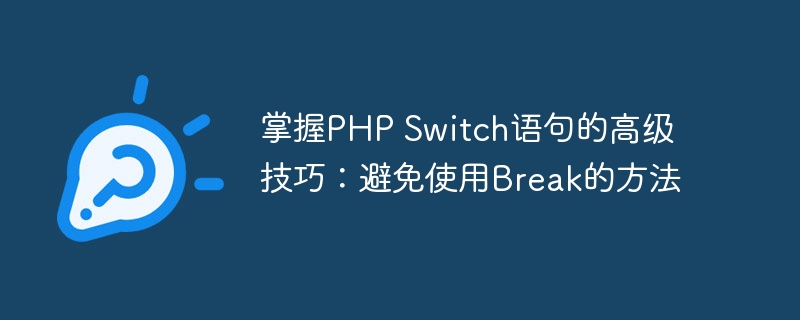

Advanced skills to master the PHP Switch statement: avoid using Break
The Switch statement in PHP is a commonly used flow control statement , usually used to execute different blocks of code based on different conditions. In the Switch statement, in most cases we will use break to terminate the current case and jump out of the switch statement, but sometimes we also need to bypass the break statement and continue to execute the next case or the default situation. This article will introduce some advanced techniques to help you better use Switch statements and avoid using break.
In some specific scenarios, we may need to bypass the break statement and let the program continue to execute the next case or default situation. The following is a simple example:
$fruit = "apple"; switch ($fruit) { case "apple": echo "Apple is red."; case "banana": echo "Banana is yellow."; case "orange": echo "Orange is orange."; default: echo "No fruit selected."; }
In the above code, if the value of $fruit is "apple", then the program will output the following content:
Apple is red. Banana is yellow. Orange is orange. No fruit selected.
Visible, because it is not used break statement, after the program matches the case "apple", it will continue to execute all subsequent cases until the switch ends. In this case, you need to pay special attention to the order of the cases and whether you need to continue to execute the code of subsequent cases.
A common alternative is to use the return statement instead of break, using return to terminate the execution of the program early and return the result. The following is an example:
function getFruitColor($fruit) { switch ($fruit) { case "apple": return "red"; case "banana": return "yellow"; case "orange": return "orange"; default: return "unknown"; } } echo "The color of the fruit is " . getFruitColor("apple");
In the above example, based on the passed in fruit name, the function getFruitColor will return the corresponding color. Using the return statement can terminate the execution of the switch statement in advance and return the result to the caller, avoiding the use of break to directly terminate the execution of the entire function.
In addition to using the return statement, you can also use the continue statement to skip the current case and continue executing the next case. The following is an example:
$fruit = "banana"; switch ($fruit) { case "apple": echo "Apple is red."; continue; case "banana": echo "Banana is yellow."; continue; case "orange": echo "Orange is orange."; continue; default: echo "No fruit selected."; }
In the above code, if the value of $fruit is "banana", then the program will output:
Banana is yellow.
Due to the use of the continue statement, the program will jump After the execution of the current case, continue to the next case or the default situation.
When using the Switch statement, avoiding the use of break can provide a more flexible method of controlling the flow. By using return and continue statements appropriately, we can achieve finer logic control without terminating the entire switch statement. However, in actual programming, you should still choose the appropriate method according to the specific situation to ensure that the code is clear and readable.
In future programming, try to use these advanced techniques and continuously improve your application of Switch statements.
The above is the detailed content of Master the advanced skills of PHP Switch statement: avoid using Break method. For more information, please follow other related articles on the PHP Chinese website!